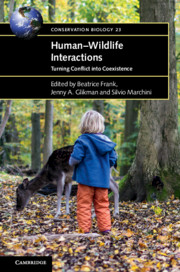Book contents
- Human–Wildlife Interactions
- Conservation Biology
- Human–Wildlife Interactions
- Copyright page
- Dedication
- Contents
- Contributors
- Foreword
- Preface
- Map
- 1 Human–Wildlife Conflicts and the Need to Include Coexistence
- 2 A Multilevel, Systems View of Values Can Inform a Move towards Human–Wildlife Coexistence
- 3 Broadening the Aperture on Coexistence with Wildlife through the Lenses of Identity, Risk and Morals
- 4 Understanding Emotions As Opportunities for and Barriers to Coexistence with Wildlife
- 5 Tolerance for Wildlife
- 6 A Framework for Assessing and Quantifying Human–Wildlife Interactions in Urban Areas
- 7 Predators in Human Landscapes
- 8 Corridor of Conflict
- 9 A Collaborative Approach for Coexistence with Wildlife in Rural Regions of Japan
- 10 Towards Tolerance and Coexistence
- 11 Elephants and Bees
- 12 The Twin Challenges of Preventing Real and Perceived Threats to Human Interests
- 13 Conflict and Coexistence with Invasive Wildlife
- 14 Institutions for Achieving Human–Wildlife Coexistence
- 15 Worldviews and Coexistence with Coyotes
- 16 Conservation Marketing As a Tool to Promote Human–Wildlife Coexistence
- 17 Leaping Forward
- 18 Towards Human–Wildlife Coexistence through the Integration of Human and Natural Systems
- 19 Planning for Coexistence in a Complex Human-Dominated World
- 20 Human–Wildlife Interactions
- Index
- Plate Section (PDF Only)
- References
10 - Towards Tolerance and Coexistence
A Comparative Analysis of the Human–Macaque Interface in Sulawesi, Indonesia, and Florida, United States
Published online by Cambridge University Press: 19 April 2019
- Human–Wildlife Interactions
- Conservation Biology
- Human–Wildlife Interactions
- Copyright page
- Dedication
- Contents
- Contributors
- Foreword
- Preface
- Map
- 1 Human–Wildlife Conflicts and the Need to Include Coexistence
- 2 A Multilevel, Systems View of Values Can Inform a Move towards Human–Wildlife Coexistence
- 3 Broadening the Aperture on Coexistence with Wildlife through the Lenses of Identity, Risk and Morals
- 4 Understanding Emotions As Opportunities for and Barriers to Coexistence with Wildlife
- 5 Tolerance for Wildlife
- 6 A Framework for Assessing and Quantifying Human–Wildlife Interactions in Urban Areas
- 7 Predators in Human Landscapes
- 8 Corridor of Conflict
- 9 A Collaborative Approach for Coexistence with Wildlife in Rural Regions of Japan
- 10 Towards Tolerance and Coexistence
- 11 Elephants and Bees
- 12 The Twin Challenges of Preventing Real and Perceived Threats to Human Interests
- 13 Conflict and Coexistence with Invasive Wildlife
- 14 Institutions for Achieving Human–Wildlife Coexistence
- 15 Worldviews and Coexistence with Coyotes
- 16 Conservation Marketing As a Tool to Promote Human–Wildlife Coexistence
- 17 Leaping Forward
- 18 Towards Human–Wildlife Coexistence through the Integration of Human and Natural Systems
- 19 Planning for Coexistence in a Complex Human-Dominated World
- 20 Human–Wildlife Interactions
- Index
- Plate Section (PDF Only)
- References
Summary
- Type
- Chapter
- Information
- Human–Wildlife InteractionsTurning Conflict into Coexistence, pp. 198 - 215Publisher: Cambridge University PressPrint publication year: 2019

